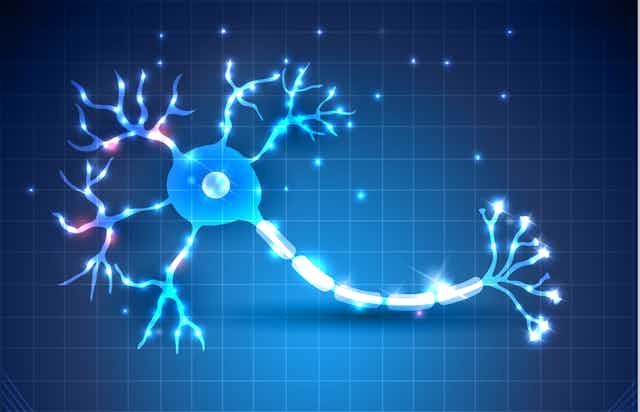Fat often gets a bad press, but if it didn’t coat the cables that connect our neurons, we’d be in a lot of trouble. Sufferers of multiple sclerosis and a host of other nervous system diseases have first-hand experience of this, with few safe and effective treatment options available. Only now are new treatments appearing on the horizon that might just make a big difference.
In order for us to think, feel and move, information must move around the brain accurately and rapidly. Vital in this process are long wire-like structures called axons, which conduct the electrical currents that encode our thoughts from neuron to neuron.
Most of our axons are sheathed in a fatty substance called myelin which, like the plastic coating on a wire, provides insulation for efficient conduction and protects the axon from damage.
Unfortunately, many diseases damage these myelin sheaths. For example, in multiple sclerosis (MS), the immune system – usually our body’s defence against disease – attacks its own myelin in the brain and spinal cord, leaving the underlying axons exposed. Like a worn-down phone charger, these bare axons can no longer conduct electricity effectively, and are vulnerable to damage. Depending on which cables are damaged, this can cause tingling, weakness, visual problems, and eventually difficulty moving, speaking and swallowing.

Most current therapies for MS attempt to stop the immune system from attacking the myelin sheaths. This can reduce damage, but it can’t reverse it. So the condition of many patients deteriorates even while on these drugs. Stem cell transplantation therapy has shown recent promise in treating MS, but such treatments are aggressive and can seriously endanger patients’ health, requiring chemotherapy to almost completely eliminate the patient’s immune system before attempting to reboot it to an earlier, more healthy stage.
Now, a different kind of stem cell offers exciting potential for a raft of new treatments that could reverse symptoms of MS and other myelin diseases, rather than just slow them – and without the need for transplantation.
A new hope
After myelin damage, stem cells called OPCs can create specialised brain cells called oligodendrocytes, which send octopus-like arms to wrap new myelin around damaged axons. OPCs are already scattered throughout the brains of MS sufferers, but only in some people do they produce enough of the specialised brain cells that regenerate myelin, and therefore reduce symptoms.
Recent years have seen great advances in our understanding of how to influence OPC stem cells to respond properly to myelin damage. We can now grow them in hundreds of tiny artificial wells, each containing a different drug and several microscopic axon-mimicking cables, and examine which drugs best kick-start the OPCs into re-myelinating action. This innovative lab technique is helping researchers to fast identify the most promising concoctions to take to clinical trials.
Surprisingly, recent discoveries also show that the same immune system responsible for attacking and damaging myelin can also play a beneficial role in regenerating it. For example, immune cells called microglia can gobble up the debris of the old myelin sheaths, clearing the way for new myelin to regenerate. Drugs targeting this process have already helped mice to regenerate mylein and will likely be seen in clinical trials soon. What’s more, new medical imaging technologies will allow us to monitor how well all of these new drugs regenerate myelin inside patients in real time.
The next few years will be an exciting time, as we begin to see clinical data on how these new drugs can help people living with MS. After years of struggle to find an effective treatment, we may just find that the key was inside our bodies all along.

